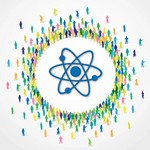World Nuclear Energy Day Date in the current year: December 2, 2026
 World Nuclear Energy Day is celebrated annually on December 2. It was inaugurated in 2020 to commemorate the first human-made self-sustaining nuclear chain reaction that was initiated on this day in 1942 during an experiment led by the Italian-American physicist Enrico Fermi.
World Nuclear Energy Day is celebrated annually on December 2. It was inaugurated in 2020 to commemorate the first human-made self-sustaining nuclear chain reaction that was initiated on this day in 1942 during an experiment led by the Italian-American physicist Enrico Fermi.Nuclear energy (nuclear power) is the use of nuclear reactions to produce electricity. Interestingly, the research that made nuclear reactors possible was originally aimed at producing the first nuclear weapons. Yes, we’re talking about the Manhattan Project, which is commonly associated with Robert Oppenheimer, but it was very much a collective effort. One of the scientists responsible for the creation of the first artificial nuclear reactor was Enrico Fermi.
Born in Rome in 1901, Fermi got interested in physics at a young age and studied it at the Scuola Normale Superiore in Pisa. He also spent several months in Germany studying under Max Born in Göttingen and under Paul Ehrenfest in Leiden. Upon his graduation, he applied for a professorship at the Sapienza University of Rome and was chosen ahead other candidates.
In 1932, Fermi focused on nuclear physics and soon achieved significant success: six years later, he was awarded the Nobel Prize in Physics for his discoveries. After receiving the prize in Stockholm, Fermi decided not to return to Italy due to his opposition to Mussolini’s regime. Instead, he took his family to the united States, where several universities immediately offered Fermi positions.
He accepted a position at Columbia University and continued his research into nuclear reactions, collaborating with a group of American physicists. They conducted the first nuclear fission experiment in the United States in January 1939 and received funding from the government to continue their experiments.
In early 1942, Fermi and his team joined the Metallurgical Laboratory at the University of Chicago to work on the world’s first nuclear reactor, Chicago Pile-1 (CP-1). Construction began on November 6, 1942, and the reactor went critical on December 2. The anniversary of its launch is observed as World Nuclear Energy Day to highlight Fermi’s contribution to the development of nuclear power.
World Nuclear Energy Day was launched in 2020, right in the midst of the COVID-19 pandemic, to highlight the commitment of people employed in the nuclear energy sector who worked tirelessly even during the pandemic to keep nuclear power plants running. The holiday also aims to raise awareness of the benefits of nuclear energy over less sustainable power sources and recognize all the people who design, build, operate, and maintain a wide range of nuclear technologies.
Like many other awareness days, World Nuclear Energy Day has a unique theme every year. Past themes have included “Industry Response to the Pandemic of COVID-19”, “A Chain Reaction”, and “Power to the People”. Countries that have joined the celebration include Australia, Bangladesh, Brazil, Canada, France, India, Indonesia, Malaysia, Nigeria, Poland, South Africa, Spain, UAE, UK, USA, and others.
As World Nuclear Energy Day originated during the pandemic, many of its events are virtual and therefore accessible from almost any corner of the world. They include webinars, online lectures and meetings, virtual lab tours, workshops, panel discussions, and more. When pandemic restrictions began to ease, stakeholders around the globe started to organize in-person events as well, such as dinner meetings and live performances.
You can join the celebration of World Nuclear Energy Day by participating in a virtual event, attending an in-person event if there is one near you, learning more about nuclear energy and sharing the facts you’ve learned with others, and spreading the word on social media with the hashtag #WorldNuclearEnergyDay.
- Category
- International Observances
- Tags
- World Nuclear Energy Day, international observances, Enrico Fermi, nuclear energy, nuclear power, Chicago Pile-1